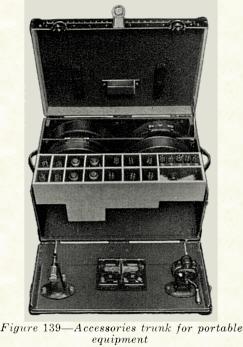When all the apparatus is in place, insert a projection lamp, an exciter lamp and a photo-cell in each
projector and the tubes in the amplifier. The photo-electric cell is placed in its socket just to the right of
the sound gate, and the shield is replaced with the hole in it to the left, or towards the sound gate. The
two UX-281, the UY-227, UY-224 and UX-250 Radiotrons are placed in the amplifier, in the sockets
provided for them. These sockets are labelled to prevent any mistake in the location of the tubes. The
UY-224 is mounted inside the shield, as shown in Figure 136. The projection lamp is inserted by
pushing it down into its pre-focused socket and giving it a quarter-turn to the right. This socket, and
the reflecting mirror behind it, may be adjusted for height. Make sure that the center of the filament and
the center of the mirror are in line with the center of the condenser lens, which is fixed in position. With no
film in the projector, turn on the light and raise the fire shutter. Focus both projectors on the screen and
aim them at the same spot so that the fields of light are exactly superimposed, using the tilting screw
under the front of the projector if necessary. Rotate the mirror on its vertical axis to obtain the brightest
and most even light on the screen.

Connect all supply cables as indicated in the cable diagram, Figure 138. In most cases the supply will be
110 volts, 60 cycle, alternating current. In places where only direct current is available, the projection
lamps must be operated from this, and a small rotary converter, described in section 35, is necessary.
When operated with one projector, one 1 1/2 k-va. converter is used. This supplies both the projector
and the amplifier. When using two projectors, one 1 1/2 k-va. converter and one 3/4 k-va.
converter are used, the larger converter as before and the smaller for the second projector.
11
